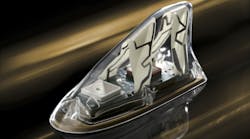A start-up whose chips would let cars chat about road hazards or impending collisions over short distances raised $30 million from investors in a recent funding round. The money gives it extra provisions as the United States prepares to mandate such technology for all cars.
The nine-year-old start-up, Autotalks, makes modem chips for vehicle-to-vehicle communications. The V2V technology lets cars equipped with specialized radios share their location, speed, and other information like airbag activation. That insight helps cars detect when other vehicles crash, brake suddenly, or speed around a blind corner.
Armed with that information, cars could automatically avoid crashes, send collision warnings to drivers, alert other vehicles about traffic, or contribute to local weather reports. The information could also be sent to road-side units, which would let cars in an accident send out distress signals or give local officials insight into traffic patterns.
Autotalks, which is based in Kefar Neter, Israel, is raising money at a critical time. Late last year, U.S. officials proposed a rule that would require all cars and light trucks to be equipped with dedicated short-range communications by 2023. To meet that goal, the first cars equipped with the technology, also known as DSRC, would be released in 2019.
The company, which has built wireless systems for automotive companies from Denso to Audi, has increased production of its chips in recent years. But with its latest funding, the start-up plans to expand its global operations in time for the United States mandate. Most of its funding comes from investors in Israel.
“Our mission to equip vehicles with such lifesaving technology is now being adopted by the regulators and leading car manufacturers,” said Hagai Zyss, the chief executive of Autotalks, in a statement. “I believe our chipsets will soon be part of most new vehicles worldwide.”
The technology, also known as DSRC, sends standardized messages 10 times per second over an average range of 1000 meters. It also depends on an exclusive part of the 5.9 gigahertz spectrum that the Federal Communications Commission reserved for automotive applications over a decade ago. Several states are gearing up for pilot tests of the technology.
The V2V technology would supplement cameras, radar, and other sensors to protect against fatal accidents, officials and industry executives say. The National Highway Transportation and Safety Administration estimates that V2V could reduce 80 percent of crashes that don’t involve alcohol or drugs.
But concerns abound about who owns the car's information and how safe the wireless systems are from hackers. While the privacy issue is still unresolved, Autotalks is marketing the security of its chips, which contain multiple layers of defense to detect suspicious signals. That is on top of the anonymous and encrypted messages used by DSRC, the company says.
Autotalks has competition from other chip suppliers. NXP Semiconductors, the world's largest automotive chip maker, sells DSRC chips that have been used for truck platooning and other safety systems. But its $47 billion sale to Qualcomm last year has thrown its future with the technology into question. Qualcomm executives have derided DSRC as a "dead-end" technology.
Qualcomm has said the technology will not survive the rise of 5G communications, which it claims will handle all the connectivity needs of cars. Many industry executives say that, while 5G is vital for remotely updating a car's software and sending sensor readings to the cloud, DSRC is more suited for split-second safety features like collision avoidance.

